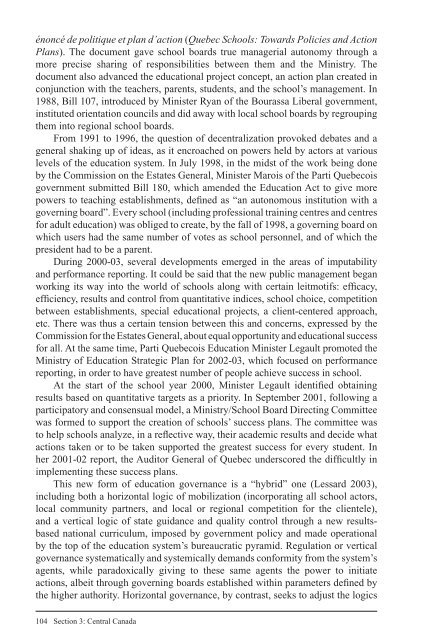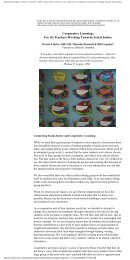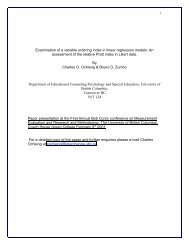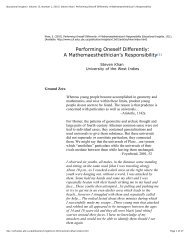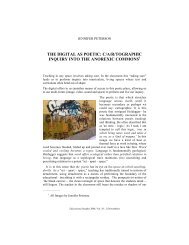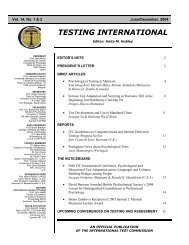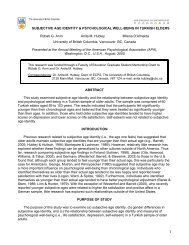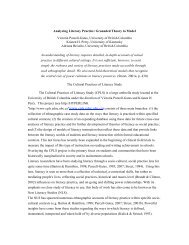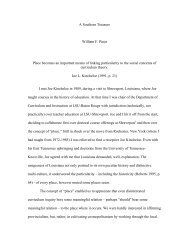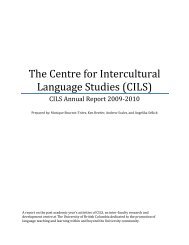The evolution of professionalism - Centre for Policy Studies in ...
The evolution of professionalism - Centre for Policy Studies in ...
The evolution of professionalism - Centre for Policy Studies in ...
Create successful ePaper yourself
Turn your PDF publications into a flip-book with our unique Google optimized e-Paper software.
énoncé de politique et plan d’action (Quebec Schools: Towards Policies and Action<br />
Plans). <strong>The</strong> document gave school boards true managerial autonomy through a<br />
more precise shar<strong>in</strong>g <strong>of</strong> responsibilities between them and the M<strong>in</strong>istry. <strong>The</strong><br />
document also advanced the educational project concept, an action plan created <strong>in</strong><br />
conjunction with the teachers, parents, students, and the school’s management. In<br />
1988, Bill 107, <strong>in</strong>troduced by M<strong>in</strong>ister Ryan <strong>of</strong> the Bourassa Liberal government,<br />
<strong>in</strong>stituted orientation councils and did away with local school boards by regroup<strong>in</strong>g<br />
them <strong>in</strong>to regional school boards.<br />
From 1991 to 1996, the question <strong>of</strong> decentralization provoked debates and a<br />
general shak<strong>in</strong>g up <strong>of</strong> ideas, as it encroached on powers held by actors at various<br />
levels <strong>of</strong> the education system. In July 1998, <strong>in</strong> the midst <strong>of</strong> the work be<strong>in</strong>g done<br />
by the Commission on the Estates General, M<strong>in</strong>ister Marois <strong>of</strong> the Parti Quebecois<br />
government submitted Bill 180, which amended the Education Act to give more<br />
powers to teach<strong>in</strong>g establishments, defi ned as “an autonomous <strong>in</strong>stitution with a<br />
govern<strong>in</strong>g board”. Every school (<strong>in</strong>clud<strong>in</strong>g pr<strong>of</strong>essional tra<strong>in</strong><strong>in</strong>g centres and centres<br />
<strong>for</strong> adult education) was obliged to create, by the fall <strong>of</strong> 1998, a govern<strong>in</strong>g board on<br />
which users had the same number <strong>of</strong> votes as school personnel, and <strong>of</strong> which the<br />
president had to be a parent.<br />
Dur<strong>in</strong>g 2000-03, several developments emerged <strong>in</strong> the areas <strong>of</strong> imputability<br />
and per<strong>for</strong>mance report<strong>in</strong>g. It could be said that the new public management began<br />
work<strong>in</strong>g its way <strong>in</strong>to the world <strong>of</strong> schools along with certa<strong>in</strong> leitmotifs: effi cacy,<br />
effi ciency, results and control from quantitative <strong>in</strong>dices, school choice, competition<br />
between establishments, special educational projects, a client-centered approach,<br />
etc. <strong>The</strong>re was thus a certa<strong>in</strong> tension between this and concerns, expressed by the<br />
Commission <strong>for</strong> the Estates General, about equal opportunity and educational success<br />
<strong>for</strong> all. At the same time, Parti Quebecois Education M<strong>in</strong>ister Legault promoted the<br />
M<strong>in</strong>istry <strong>of</strong> Education Strategic Plan <strong>for</strong> 2002-03, which focused on per<strong>for</strong>mance<br />
report<strong>in</strong>g, <strong>in</strong> order to have greatest number <strong>of</strong> people achieve success <strong>in</strong> school.<br />
At the start <strong>of</strong> the school year 2000, M<strong>in</strong>ister Legault identifi ed obta<strong>in</strong><strong>in</strong>g<br />
results based on quantitative targets as a priority. In September 2001, follow<strong>in</strong>g a<br />
participatory and consensual model, a M<strong>in</strong>istry/School Board Direct<strong>in</strong>g Committee<br />
was <strong>for</strong>med to support the creation <strong>of</strong> schools’ success plans. <strong>The</strong> committee was<br />
to help schools analyze, <strong>in</strong> a refl ective way, their academic results and decide what<br />
actions taken or to be taken supported the greatest success <strong>for</strong> every student. In<br />
her 2001-02 report, the Auditor General <strong>of</strong> Quebec underscored the diffi cultly <strong>in</strong><br />
implement<strong>in</strong>g these success plans.<br />
This new <strong>for</strong>m <strong>of</strong> education governance is a “hybrid” one (Lessard 2003),<br />
<strong>in</strong>clud<strong>in</strong>g both a horizontal logic <strong>of</strong> mobilization (<strong>in</strong>corporat<strong>in</strong>g all school actors,<br />
local community partners, and local or regional competition <strong>for</strong> the clientele),<br />
and a vertical logic <strong>of</strong> state guidance and quality control through a new resultsbased<br />
national curriculum, imposed by government policy and made operational<br />
by the top <strong>of</strong> the education system’s bureaucratic pyramid. Regulation or vertical<br />
governance systematically and systemically demands con<strong>for</strong>mity from the system’s<br />
agents, while paradoxically giv<strong>in</strong>g to these same agents the power to <strong>in</strong>itiate<br />
actions, albeit through govern<strong>in</strong>g boards established with<strong>in</strong> parameters defi ned by<br />
the higher authority. Horizontal governance, by contrast, seeks to adjust the logics<br />
104 Section 3: Central Canada


